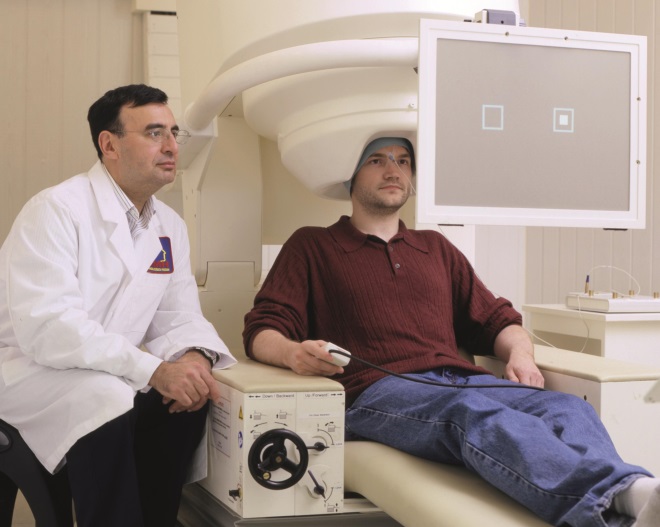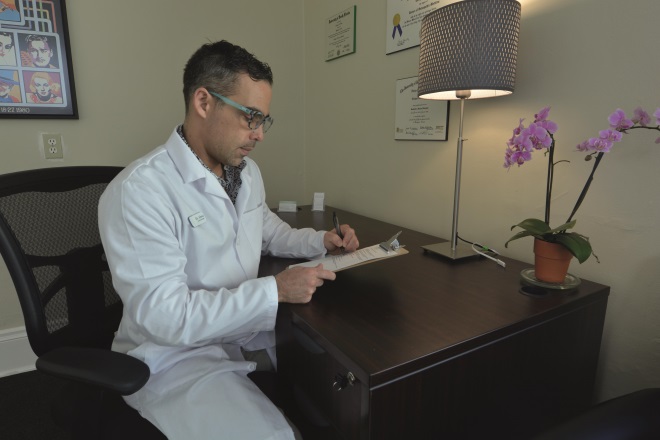
David W. Hamilton / Alamy
It rains for 164 days out of each year in Portland, Oregon, a city renowned for its wet weather. So it seems an unlikely destination for patients hoping to alleviate their depression. Yet, over the past two years, almost a hundred people have visited a small nondescript clinic in this damp corner of Northwestern United States to receive ketamine, an experimental treatment for depression that can work where other drugs have failed.
In the United States and Canada, more and more doctors are quietly beginning to prescribe the licensed anaesthetic off-label to patients. In 2006, results from the first randomised controlled trial (RCT) of ketamine for treatment-resistant depression suggested it can reverse major depression in as little as an hour[1]
— when more conventional pharmaceuticals can take weeks to start working, if at all. “These people come to me at their wits end and by their third or fourth infusion of ketamine they’re like a different person,” says Enrique Abreu, medical director of the Portland Ketamine Clinic. “I have not seen any other medicine that has such a profound effect in such a short space of time.”
Ketamine has been used as anaesthesia during short operations and pain relief during minor procedures for the past 40 years. Like a number of the other doctors offering ketamine for depression, Abreu is an anaesthesiologist experienced in administering ketamine in the operating theatre. He prefers to closely guard the location of the clinic he opened in 2013 for fear that thieves will target his stock of ketamine, which can be sold on the nightclub scene.
Abreu is not alone in his caution. Only 18 clinics are publically listed on the Ketamine Advocacy Network, a website that provides a platform for discussing ketamine’s use in depression, but the real number of clinics that have sprung up across the United States is likely to be closer to 60. “There are at least three times as many clinics doing it but not publicising it,” says Abreu. When he started his clinic he didn’t advertise for a year. This was also because he was scared of the reaction. “I didn’t want the community to think oh, this is just some quack job, there is this stigma and it is hard to get around.”
In the 1990s, it became apparent that the dissociative effects of ketamine had made it popular on the clubbing scenes of Europe and Asia. Estimates put population use of ketamine at 1% in Denmark and 0.5% in Thailand.
At the moment, ketamine is not subject to international controls, which are designed to limit the abuse of recreational drugs. But China has now placed a proposal before the United Nations Commission on Narcotic Drugs to have ketamine placed in schedule 1 of the Convention on Psychotropic Substances of 1971. This would put ketamine under the tightest possible international restrictions — usually only reserved for drugs with a very narrow medical application and high abuse potential. The World Health Organization (WHO) is opposing the move, saying that it does not believe the threat to public health is significant enough to warrant international controls. It says scheduling would limit access to ketamine in poor countries where it is a vital anaesthetic with a wide safety margin, and the restrictions would also make research in Western countries more difficult.
But in an unprecedented move, the UN has decided to press ahead with a vote on scheduling the drug, which will take place during the Commission’s 58th Session held in Vienna in March 2015. This contravenes the UN’s own commentary on the 1971 Convention, which prohibits it from placing a drug in schedule 1 against the advice of WHO.
Despite this legal challenge, many doctors are determined to see ketamine help patients. It has shown great promise in hard-to-treat depression over the short term, as well as treating bipolar depression and suicidal ideation. Meanwhile, researchers are trying to figure out how the drug actually works and pharmaceutical companies are racing to develop analogues of ketamine without the dissociative side effects.
Glimmer of hope
Antidepressants are among the most widely prescribed drug classes, explains Jonathan Roiser, head of the cognitive neuropsychiatry laboratory at University College London Institute of Cognitive Neuroscience. There were 53 million prescription items for antidepressants dispensed in the community for patients in England in 2013 — a region with a population of 53.9 million people. Globally, it is estimated that depression affects 350 million people. Yet over the past 50 years, drugs to treat depression have not radically changed, despite the fact that for around a third of patients these drugs do not work. This is what makes the prospect of a new drug so attractive.
When Abreu first heard about ketamine’s effects on depression, he was reluctant to believe it. But one particular patient changed his mind. Abreu operates a mobile anaesthesia service for dental practices. In 2013, he was at a practice two hours outside of Portland when he was approached by a patient. “He saw I was an anaesthesiologist and asked whether I could treat him with ketamine for his depression.” Initially, Abreu dismissed the request, assuming that he wanted to misuse the drug. After doing some research of his own Abreu realised the man was speaking factually and about a month later got back in touch with him. After consulting with his psychiatrist, he agreed to go ahead with administering him ketamine. The results were so impressive, he says, that he was convinced of ketamine’s benefits.
In the research community there is equal enthusiasm. “Ketamine is the most exciting thing in psycho pharmacology for 50 years. There is a lot of work going on around the world,” says Rupert McShane, consultant psychiatrist at Oxford Health NHS Foundation Trust in the UK. Ketamine is now in numerous phase II and III clinical trials, primarily in the United States and Canada. McShane led the first UK study of ketamine for treatment-resistant depression, published in 2014. A total of six infusions were given to 28 patients and after six months of follow-up, there were no major safety concerns[2]
. McShane runs one of three NHS research clinics looking at ketamine, the other two are in Newcastle and London.
Novel action
One of the major points of interest for researchers is that ketamine seems to work so differently to other drugs used to treat depression. Selective serotonin reuptake inhibitors and serotonin–norepinephrine reuptake inhibitors target the serotonin and noradrenaline systems: “The rationale for focusing on serotonin really comes from the drugs themselves — early drugs were identified by accident in the 1950s and 1960s and subsequent drugs were just refined,” says Roiser. The mid-1990s was the last boom time for antidepressants, he says, with citalopram and fluoxetine hitting the market. “They act slightly differently to the previous drugs, but have the same effect of increasing serotonin and noradrenaline.”
But the brain has very few serotonin or noradrenaline neurons. There are around 50,000 noradrenaline releasing neurons in the brain and 500,000 for serotonin, out of around 85 billion neurons on average. “They innervate a lot of areas but they are not part of the mainstay of how the brain transmits signals,” says Roiser.
In contrast, ketamine has a completely different mechanism of action, he says. It blocks the N-methyl-D-aspartate (NMDA) receptor, this stops signals from the central nervous system being picked up causing anaesthesia, but it also has more widespread effects on the brain’s signalling system. “Its effect on depression is probably mediated by the glutamate system,” he says. The glutamate system is the major excitatory neurotransmitter system in the brain; 90% of neurons use it.
The other unusual thing is that it works very quickly, says Roiser. Other medications for depression can take between six and eight weeks to work. “Ketamine works within 24 hours, it’s a really exciting advance,” he says. This is much better for patients, explains Roiser, because they can go back to work quicker and it could even prevent suicide attempts. “It’s a relatively short term effect though, about two weeks later patients are usually depressed again. It’s completely different to other medications.”
Many of the advances in ketamine research have been led by Carlos Zarate, chief of the Neurobiology and Treatment of Mood Disorders section and of the Experimental Therapeutics and Pathophysiology Branch at the National Institute of Mental Health (NIMH), Bethesda, Maryland. He believes that the legal debate is currently the biggest challenge for ketamine medically. “Right now, the main concern is the debate going on with WHO and the UN,” says Zarate. He says this is especially visible in the UK, where ketamine analogues have been banned and ketamine itself upgraded from a class C to a class B drug. But he says researchers are fighting tight restrictions on ketamine. “The depression angle is starting to be included in the debate,” he adds.
Growing evidence
The effect of ketamine on depression may never have been recognised were it not for Zarate himself. McShane says that in 2006 “interest was sparked because of a paper published by Zarate, who conducted the first randomised controlled trial (RCT) of ketamine for treatment resistant depression”.
In a small trial of 18 patients at the National Institute of Mental Health Clinical Research Center in Bethesda, Maryland, there was a significant improvement in depression after two hours in patients given a single ketamine infusion compared with placebo, and 70% met clinical response criteria after 24 hours, as rated on the Hamilton Depression Rating Test[1]
.

Source: Mental Health Clinical Research Center in Bethesda, Maryland
Carlos Zarate with a patient undergoing magnetoencephalography (MEG)
Since that initial study, Zarate estimates that ketamine has been studied in around 200 patients with unipolar depression and 60 with bipolar depression. A recent meta-analysis of eight randomised controlled trials showed that patients with major depressive episodes (n=183) given a single infusion or intranasal dose of ketamine are seven times more likely to have clinical remission of symptoms after 24 hours compared with placebo infusion or midazolam (odds ratio 7.06, number needed to treat [NNT] = 5) and four times as likely after seven days (OR 4.00, NNT=6)[3]
.
In another analysis of five trials (n=165), a single infusion of ketamine was effective in 50–70% of patients, with effects seen as soon as 40 minutes after administration. However, patients usually relapsed after a week. In contrast, an RCT of six ketamine infusions produced a response rate of 70.8% and time to relapse was on average 18 days[4]
.
For Zarate, his work initially focused on proving whether ketamine helped patients with depression. However, it has now evolved and he is trying to understand what it is about ketamine that elicits these rapid responses.
He explains depression as a disease of the synapses between neurons and, on a bigger scale, the circuits in the brain. Ketamine “rapidly modulates the circuits and synapses in the brain”, says Zarate. Depressed patients often lose connections between neurons. The release of glutamate increases formation of new brain synapses and the density of a neuron’s “dendritic spines” — the long and thin protrusions at the end of a neuron that help it to pick up signals across a synapse. “This can restore synaptic connectivity, which can be lost due to depression, and then the circuits start functioning better,” he says.
Zarate is now studying the various changes in brain circuits to try to understand the mechanism of response and non-response. He is using a “multimodal” approach that combines genetics, chemistry and proteomics with a battery of brain imaging techniques, including positron emission tomography (PET), magnetic resonance spectroscopy, functional magnetic resonance imaging (MRI), 3 Tesla MRI, and 7 Tesla MRI. “We don’t want the traditional polaroid picture of a treatment,” says Zarate. Using these imaging techniques, he is looking at brain function before treatment, during response to treatment and when patients have relapsed.
For patients with depression, ketamine can have anti-anxiety and anti-depressive effects and lift mood. Zarate’s team hopes to zero in on changes in brain function and link them to the effect on specific symptoms. One of these symptoms is anhedonia — a lack of motivation or ability to experience pleasure. Niall Lally, a researcher at the University College London (UCL) Institute of Cognitive Neuroscience, conducted this research with Zarate as part of his PhD. “Anhedonia is a difficult to treat symptom. Typical antidepressants primarily work on mood and anxiety,” he says. Ketamine was found to rapidly reverse anhedonia. Lally linked this to activation of the anterior cingulate cortex, an area of the brain involved in conflict and decision making[5]
.
In spring 2015, Zarate will be using these imaging techniques in patients who have recently attempted suicide. Zarate says the effectiveness of ketamine in suicidal patients is now well established: “There have been five or six studies that show it produces rapid anti-suicidal effects.” He explains that when people who have suicidal ideation receive an infusion of ketamine they can have improvements in 40 minutes that can last anywhere between three days and seven days. “That’s pretty pronounced,” he says. So now he is trying to understand the biology behind this.
Going mainstream
Mounting evidence is convincing more clinicians to offer the experimental treatment. The team at the NIMH is working on refining the dosing regimen, which Abreu in Portland says is “great” because every few months he can access the new data. Based on this, he has devised his own treatment method.
“We do three treatments every other day and then they decide if it’s helping them or not. At 72 hours, patients definitely know,” says Abreu. If the first three treatments are successful then the best way to prolong the effect for as long as possible is six treatments in total, he says. He gives patients an infusion of 0.5mg/kg over 40 minutes, the standard dose used in clinical trials. “Every once in a while, maybe 20–30% of the time, I have to increase the dose,” says Abreu. In comparison, a dose of 2mg/ml is used during anaesthesia.
Before the infusion, patients complete the PHQ9 questionnaire for depression, which Abreu says is used as a rough gauge of their mental state. After the infusion, patients have a recovery period to allow the dissociative effects of the drug to wear off. From start to finish, each session takes about 1.5 hours. Overall his response rate is “somewhere between 68–75%” for the roughly 100 patients who have visited his clinic.
One of the biggest challenges for Abreu is selecting who to treat. “You do get overwhelmed with the phone calls and interest and that in itself is a challenge because you have to be able to weed out the people that are for real and the people that are trying to get high,” he says. He also rejects patients with certain concomitant psychological conditions and those on certain drugs. For example, monoamine oxidase inhibitors can cause hypertension or tachycardia and so are not given in combination with ketamine. In addition, Abreu has found that addiction to benzodiazepines is a big problem. Ketamine doesn’t work at all in these patients, says Abreu. This is an effect that he says has been noticed by all the doctors who run clinics, although at the moment they can only guess at why this is the case. “So these patients have to be weaned off this drug before we can treat them,” he adds.
Holistic care
The profound effect of ketamine on some patients is inspiring a range of medical specialists to provide it off label. Abreu explains that “anaesthesiology is a great job and it’s fascinating but it doesn’t give you that feeling that you’re making a difference”.
Allan Young, director of the Centre for Affective Disorders Institute of Psychiatry, Psychology & Neuroscience at King’s College London, believes that ketamine should not be administered by anaesthesiologists for an area of medicine that’s not their speciality. “I would suggest it’s embedded in a mental healthcare package and that psychiatrists are involved too.”
And Abreu agrees. He requires patients to sign a data release form allowing him to confirm the diagnosis of depression with their mental health professional. In addition, he mandates that patients take part in ongoing cognitive behavioural therapy (CBT), also under the supervision of a mental healthcare professional. He partners with a group based in his same facility that is run by a psychiatrist. “Patients have to have CBT to continue to be patients at our clinic,” he says. “But it’s also about diet, exercise and lifestyle. It’s not a magic trick, it requires effort on their behalf and my behalf.”

Source: Portland Ketamine Clinic
One of the treatment rooms at the Portland Ketamine Clinic in Oregon
Long-term safety
At the beginning of the treatment process, many patients are fearful of ketamine because of its reputation. “Patients that come to me are motivated to get better but highly doubtful and scared of the side effects, especially hallucinations,” says Abreu. But a short time after treatment with ketamine, patients are often amazed by the results, he says. “After their treatment they’re sometimes in a state they haven’t been in for ten years.”
From a research perspective, Zarate says that for the most part, ketamine is well tolerated, with mild to moderate side effects. “When you ask patients, they say the pain of experiencing depression is much more than five or ten minutes of these dissociative effects. And a lot of these patients have been on other medications for decades and have experienced the side effects of these drugs, so it has to be put in the context of that too.”
He is confident that many patients are willing to tolerate the dissociative effects of ketamine. “It is worth noting that there are already scores of clinics in the United States, probably a dozen in New York alone, which are using ketamine to treat depression. So yes, tolerability is very important but there are groups of people who are very interested.”

Source: Portland Ketamine Clinic
Enrique Abreu at the Portland Ketamine Clinic in Oregon
But, the biggest question mark that hangs over ketamine is whether it is safe for continued use. Its effects are short lived, patients usually relapse two weeks after a single injection, and no one is sure of the best way to administer it long-term.
UCL’s Lally warns that “people who have taken a lot of ketamine over a long period of time can appear cognitively similar to patients with schizophrenia”. “We just don’t know if it’s safe for long-term use in patients,” he says. Zarate has similar concerns about long-term use but says the issue is that abusers of ketamine, who have been found to have cognitive problems, take hundreds of milligrams a week. “There have been a number of studies that show cognition is improved under medical conditions but these haven’t been systematic,” he says. In addition, he reasons that compared with these concerns, untreated depression could be even worse as it has a deleterious effect on the brain.
Other side effects of ketamine can also be very damaging, such as bladder problems, adds Lally. But Young says bladder problems and addiction are not effects that have been observed in clinical trials, although they are a problem with recreational use.
“In my opinion… there’s no danger really at these small doses,” says Abreu. “I understand we don’t have a decade of data on this and I get that. But the data we have on patients who have abused this is anecdotal and they’ve taken huge quantities, like gram amounts really frequently.” If you gave a patient paracetamol at 30 times the normal dose they’d have liver failure, he argues.
So despite the uncertainties, some patients have been receiving ketamine long term in clinics. At the Portland Ketamine Clinic there are three patients who have been in treatment for two years and ketamine continues to alleviate their depression. “They have had between 18–26 treatments each with no negative side effects,” says Abreu. That’s an average of one infusion every six and a half weeks.
After the initial course of six treatments, Abreu will wait until the patient says they feel their depression returning before administering another infusion.
Ketamine analogues
Zarate says researchers don’t yet know if there is enough evidence to petition the US Food and Drug Administration for approval in depression. But in the years to come, the future of ketamine may not be ketamine at all. A number of companies are developing different forms of ketamine and a number of studies are going on with drugs that target the glutamate system. “People are looking at more selective drugs and trying to bypass the dissociative side-effects,” says Zarate. “It would be really exciting if one of them is approved because it would be the first time in 50 years that a drug with a novel mechanism of action has been found for depression.”
Pharmaceutical company Janssen, headquartered in Titusville, New Jersey, is pursuing esketamine. Ketamine itself is a mixture of two molecules that contain the same elements but in a mirror image, called enantiomers, of which esketamine is one. It has now completed several phase II studies with esketamine and ketamine that included a total of 200 patients, and is preparing to start a phase III programme with intranasal esketamine this year. In November 2014, the FDA designated esketamine a ‘breakthrough therapy’ for treatment-resistant depression.
In addition, pharmaceutical company Naurex in Evanston, Illinois, is working on GLYX-13, a novel NMDA receptor glycine-site functional partial agonist, which has shown success in phase 2 trials. However, other companies developing analogues of ketamine have not been as successful. Roche’s development of the drug decoglurant, which targets the glutamate system, was terminated due to a lack of efficacy. AstraZeneca’s development of lanicemine, an NMDA channel blocker, was also terminated.
Abreu believes the first couple of new drugs they come out with will not be as good as intravenous ketamine so it will remain gold standard for a while. “It will take time before they develop something with a low side effect profile that still works as well as ketamine,” he says. Eventually, Abreu believes there will be versions of these ketamine drugs that will work well in patients and it will hopefully mean they won’t have to have an intravenous infusion. In the meantime, he thinks there will be more ketamine clinics popping up and says that he “hopes they do it properly”.
References
[1] Zarate CA, Singh JB,Carlson PJ et al . A randomized trial of an N-methyl-D-aspartate antagonist in treatment-resistant major depression. Arch Gen Psychiatry. 2006;63:856–864.
[2] Diamond PR, Farmery AD, Atkinson S et al. Ketamine infusions for treatment resistant depression: a series of 28 patients treated weekly or twice weekly in an ECT clinic. Journal of Psychopharmacology 2014. doi:10.1177/0269881114527361.
[3] McGirr A, Berlim MT, Bond DJ et al. A systematic review and meta-analysis of randomized, double-blind, placebo-controlled trials of ketamine in the rapid treatment of major depressive episodes. Psychological Medicine 2015;45:693–704.
[4] DeWilde KE, Levitch CF, Murrough CF et al . The promise of ketamine for treatment resistant depression: Current evidence and future directions. Annals of the New York Academy of Sciences 2015. doi: 10.1111/nyas.12646.
[5] Lally N, Nugent AC, Luckenbaugh DA et al. Neural correlates of change in major depressive disorder anhedonia following open-label ketamine. Journal of Psychopharmacology 2015. doi:10.1177/0269881114568041.


